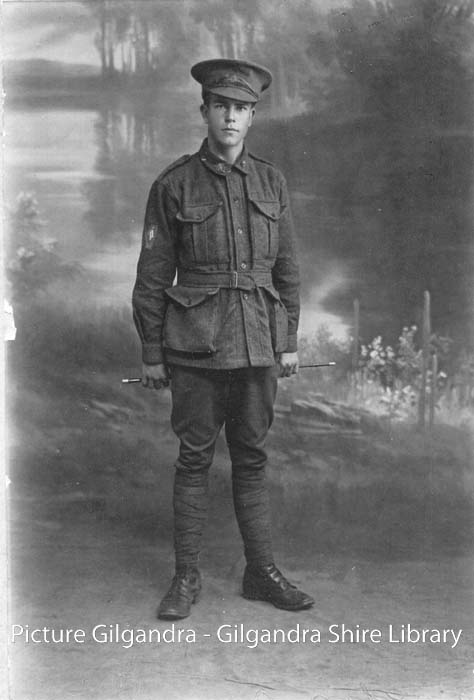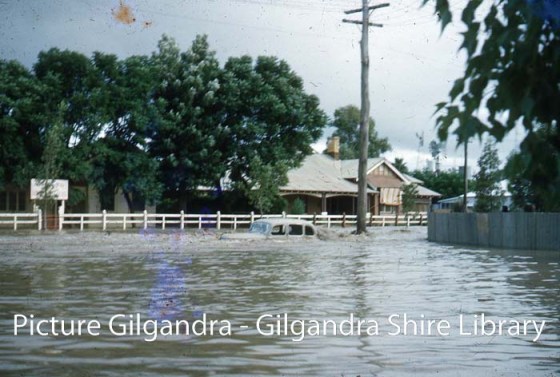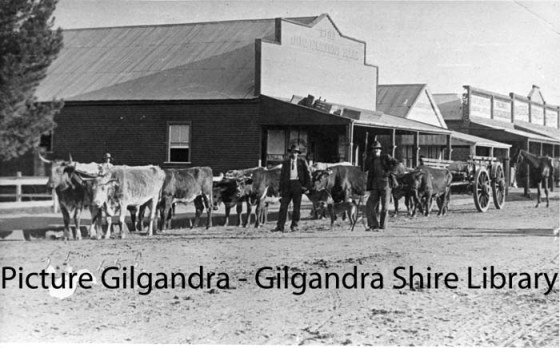This is a copy of the original photograph. The following was on the back of the photograph: Alfred Rupert Lynne[Pug] born Dubbo 1897, resided Warren Road, Gilgandra. Joined the Cooee March and enlisted in the Australian Military Forces on 13 October 1915. He served in Egypt and Palestine with 13th Battalion Signal Squadron. He returned to Australia aboad the H.T.”Malta” on 3 July 1919. After returning from war service he rejoined the Postal Department as a telegraphist at Sydney GPO and Wagga Wagga then promoted as Postmaster in country towns. Alfred Lynne passed away 5 September 1952 aged 55 years and was buried at the Woronora Cemetery, Sutherland, Sydney.
Author Archives: historygilgandra
Elephant Races in Gilgandra
Girls at Balladoran Sunday School
The 1955 Flood: Businesses
The shops in the photo above were located where the Windmill Motel and Gilgandra Toyota are today. The white sign in the middle says “Ladies and Gentlemen’s tailor, Tony Molik”. The shop to the right of the tailor is believed to have been a menswear shop. On the sign “menswear” is legible, but the actual name of the shop is indistinguishable. It is believed that Holswich’s had a clothing shop, but it is not confirmed whether these were their premises or not.
On the house on the left, the height the floodwater reached is visible. This house was built by Tony Shalhoub.
Gilgandra Tennis Club Players
The 1955 Flood: The hole in Morris Street
The 1955 Flood: Houses
Coronation Hall
The first documented movie screenings in Gilgandra were held at Coronation Hall in around 1908. They showed silent lantern slide pictures there, and later, black and white films imported from the USA. Vaudeville shows also used the building, as did travelling hawkers. Beside the Hall was an open air picture show. A ship’s searchlight was used to let everyone know that a performance was about to begin.
Pictured here is M.J. Thompson and his bullock team in front of Coronation Hall somewhere between 1902 and 1918.
Coronation Hall was built in 1893 by the Miller brothers [children of Jane (nee Wrigley) and Alexander Miller] and was located where Wrigley Street meets Miller Street [the current location of the Tyre Service]. It is believed that it was originally known as Miller’s Hall, and renamed Coronation Hall in 1902 after King Edward VII was crowned. The building was destroyed by fire in 1918.
For more information about cinemas in Gilgandra, see Thematic History of Gilgandra Shire Part 3, pages 80 and 81.
Beryl McAnally and Bertha Foran and her daughters
The Imperial Camel Corps: William Beaver
From the Australian War Memorial:
The Imperial Camel Corps (ICC) was formed in January 1916 in order to deal with the revolt of pro-Turkish Senussi tribesmen in Egypt’s Western Desert. The first four companies were recruited from Australian infantry battalions recuperating after Gallipoli. Four battalions were eventually formed. The 1st and 3rd were entirely Australian, the 2nd was British, and the 4th was a mix of Australians and New Zealanders. The ICC also had its own machine gun unit, and a battery of light artillery recruited in Hong Kong and Singapore.
The operations of the ICC in the Western Desert in 1916 were characterised by long patrols and brief skirmishes with the Senussi. British commanders in Egypt appreciated the fighting qualities of the ICC and in late 1916 the ICC was transferred to the Sinai desert to take part in operations against the Turkish army. Here the battalions of the ICC fought alongside Australian light horse units at Romani, Magdhaba and Rafa.
The ICC remained an integral part of the British and dominion force that advanced north through Palestine in 1917 and 1918. It suffered particularly heavily during the Second Battle of Gaza on 19 April 1917, and in the operations conducted in November to destroy the Turkish defensive line between Gaza and Beersheba. As the ICC moved into the more fertile country of northern Palestine, its practicality declined. The camels needed more fodder and water than equivalent numbers of horses, and, unimpeded by the desert, horses could move much faster. The bulk of the ICC was disbanded in June 1918 and the Australians were used to form the 14th and 15th Light Horse Regiments.
The men of the ICC had a rough reputation, largely because when the Corps was originally formed Australian battalion commanders had seized upon it as an opportunity to offload some of their more difficult characters. In 1917 a British supply dump at Rafa was warned to double their guards as the ICC was going to be camped nearby. The men of the ICC were, however, resourceful and effective. While defending a hill called Musallabeh in April 1918, some Australians of the ICC ran out of hand grenades. They resorted to heaving boulders down upon the attacking Turks and eventually fought them off. The hill became known as the “Camel’s Hump”.
The man second from the left in the back row is Private William Thomas Henry Beaver. He enlisted on 27 January 1916 and was one of the May 1916 Reinforcement, embarking from Sydney onboard RMS Morea. He returned to Australia, 12 November 1917.















